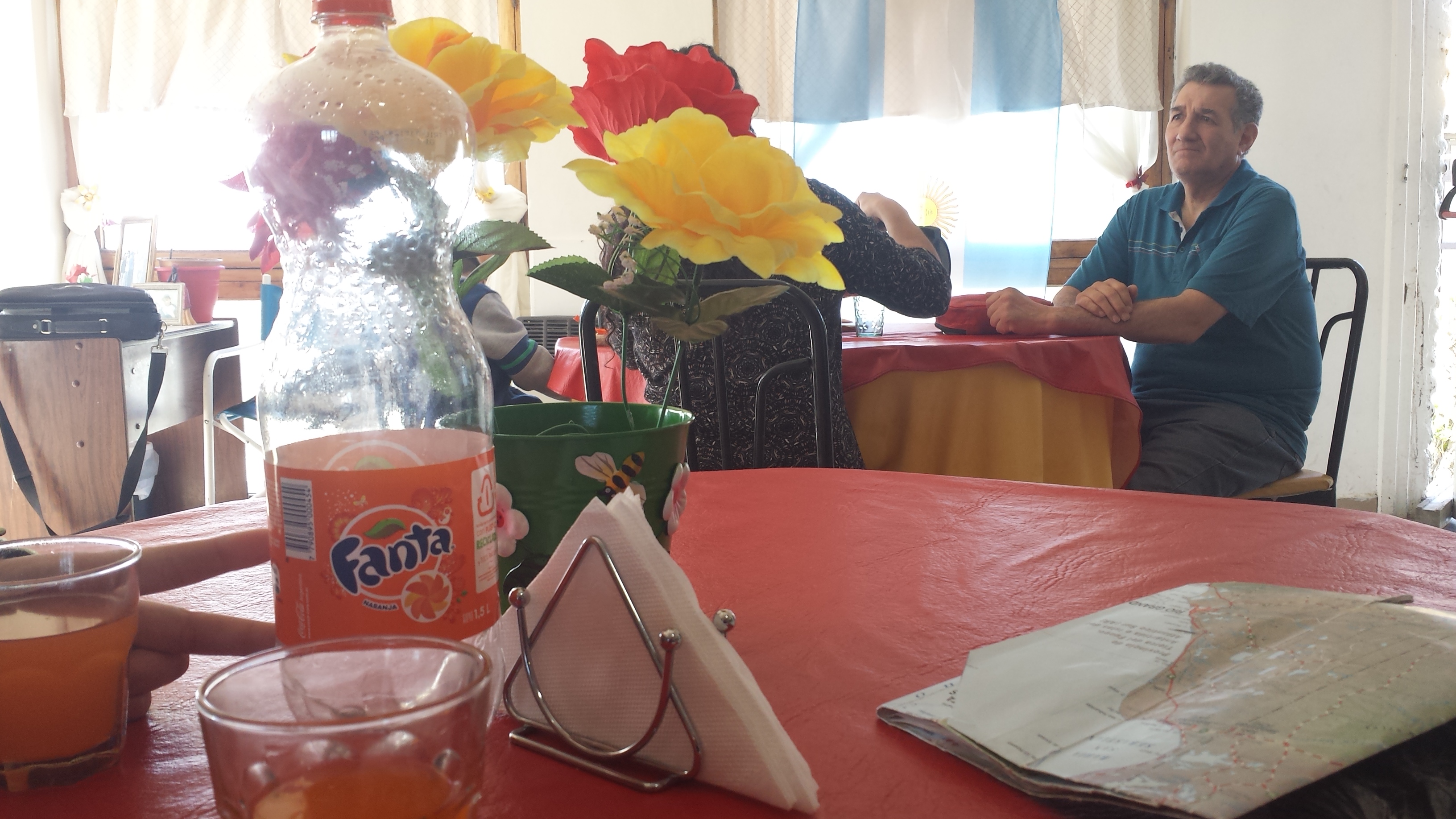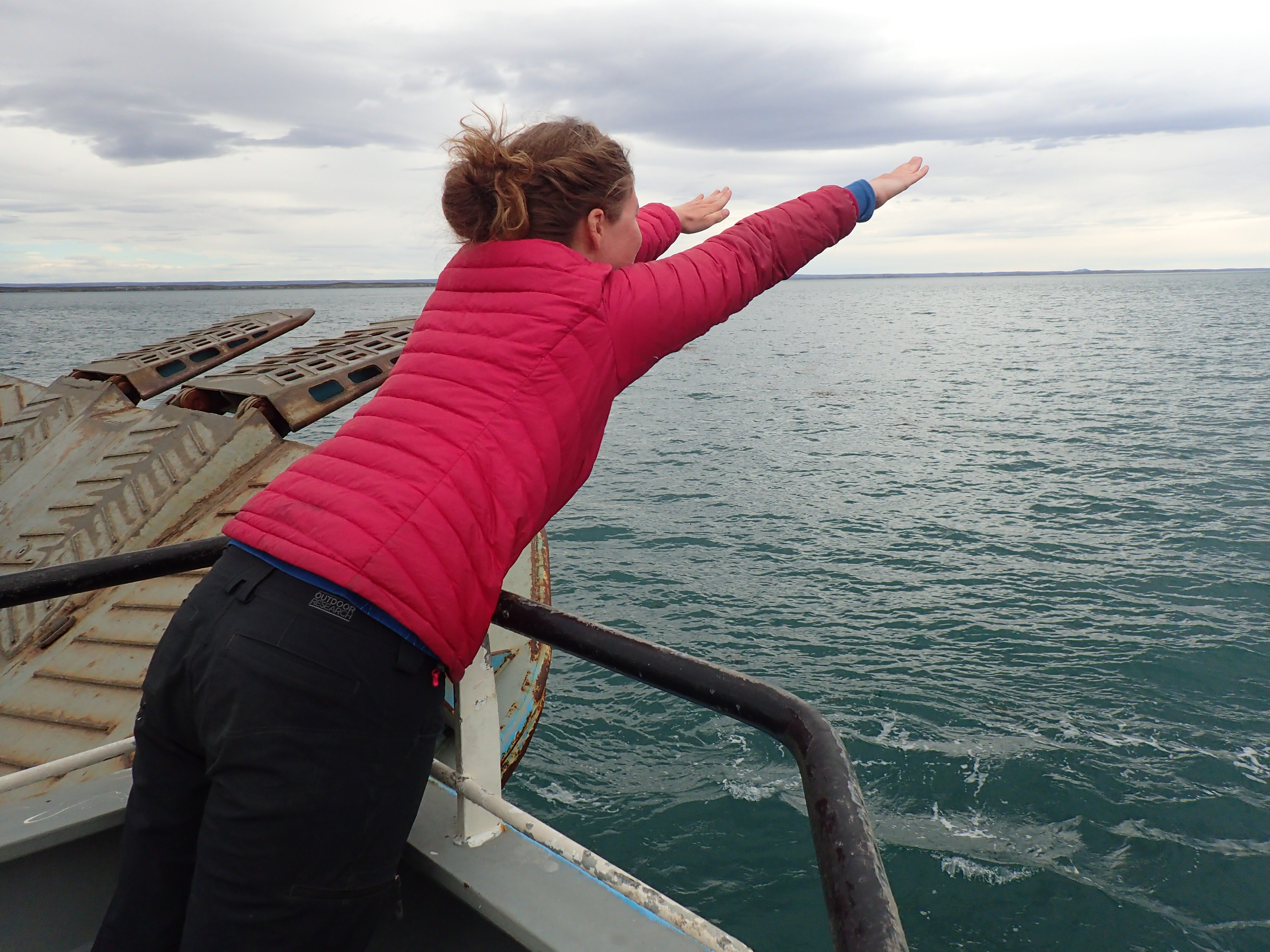Haz clic aquÍ para leer en español
Walking alongside route 3 across the flat grasslands of Tierra del Fuego, the battle was mostly mental. Leaning hard against the constant wind and with little to entertain ourselves, we were grateful when cars driving by acknowledged us with a beep of the horn. I spent an undue amount of time wondering why men shouting piropos from the street corner bothered me but truckers honking at us felt encouraging. I settled on the idea of intent.

One lunch break we came upon a seaside cliff (an actual land feature on this otherwise flat stretch!) with a colony of shrines. We had become accustomed to seeing such small memorials frequently alongside the road, memorializing lives lost to traffic incidents.
From afar we guessed that a bus must have crashed here. As we got closer, we noticed the telltale red banners of Gauchito Gil, Patagonia’s Robin Hood. There were at least 40 shrines, in all sizes to different saints and personas. Some were larger and afforded a break from the ubiquitous winds, which grow stronger as the day progresses.
We hunkered down inside Gil’s shrine to eat as a steady stream of people came through to genuflect, pour wine over one of the dozens of statues to the Gauchito, light a cigarette and set it to burn in holders made just for this purpose.
Some came to ask for favors. Others came to thank him for granting their requests. The small room was filled with boxes of wine, candles, statutes in all sizes, pictures of cars, shoes, keys, and flags with his prayer.
While he seems to prefer booze and smoke, I left the greatest sacrifice I could: one of my crackers with cheese.
Then again, north, to Estancia Las Violetas where Marcelo had called ahead and asked them to give us a space to set up our tent out of the wind. Instead Sebastian, owner of this 440 hectare oceanfront estancia put us up in one of their halls. It was a good rest.
The next day was largely uneventful. Folks driving by would honk encouragement. We found a soccer ball to kick along and entertain us for the morning. Winds were calm in the morning, roaring by mid afternoon, kilometers markers along the highway denoting our progress.
The second night we slept in a sheep barn on Estancia Sara. By now, we were savvy to the routine and finally understood locals’ urgings to take average of the mornings and the fact that the sun rises very early this time of year (around 5 am), and we hit the road by 7, under a calm mist.
That afternoon, we arrived at San Sebastian, on the Argentine side. Not much here but the Hosteria was clean, had wifi, and was run by a friendly gentleman who had seen us walking over the past 3 days.
 He would not have us pay for the Fanta we enjoyed. Anxious to meet Coach Dani on the Chilean side the next morning, we mistakenly assumed the Chilean side of the border would offer the same amenities.
He would not have us pay for the Fanta we enjoyed. Anxious to meet Coach Dani on the Chilean side the next morning, we mistakenly assumed the Chilean side of the border would offer the same amenities.
We hitched the east-west and insanely windy stretch of unpaved road between the countries. The border checks went smoothly.
San Sebastian, Chile is exactly what one might expect of an old west town. A few buildings in most of sprawling flats. One overpriced Hosteria complete with no internet connectivity, electricity off a generator for only a few hours each evening, and an indifferent barmaid.
Grateful at least for a shower and to wash our feet, we were able to message Dani to rendezvous the next morning and hitch off the island and around to the mainland, to the city of Punta Arenas, where we will begin our trek on the mainland of South America.

A San Sebastian
Traduccion por Henry Tovar
Caminando junto al a ruta 3, a través de las praderas planas de Tierra del Fuego, la batalla es sobre todo mental. Inclinada con fuerza contra el viento constante y con poco para entreternos a nosotras mismas, estamos agradecidas cuando los cuando los autos que pasaban por la carretera nos reconocian con un pitido de sus bocinas. Pasé una cantidad excesiva de tiempo preguntándome el por qué me molestó tanto el que los hombres me gritaran piropos en la calle, pero los camioneros que tocaban la bocina a nosotras se sentía alentador. Me asente en la idea de la intención.

Una pausa para el almuerzo y llegamos a un acantilado en la playa (una característica real de la tierra en este tramo que es plano) con una colonia de santuarios. Nos acostumbramos a ver estos pequeños monumentos conmemorativos con frecuencia junto a la carretera, en memoria de las vidas perdidas en accidentes de tráfico.
Desde lejos se intuía que un autobús debío haber chocado aquí. Cuando nos acercamos, nos dimos cuenta de las banderas rojas indicadoras de Gauchito Gil, el Robin Hood de la Patagonia. Hubo al menos 40 santuarios, de todos los tamaños, a diferentes santos y personajes. Algunos eran más grandes y proporcionaban un descanso del viento que venia en todas direcciones, que se hacen mas fuertes a medida que avanza el día.
Nos metimos de cuclillas en el interior del santuario Gil para comer, al tiempo que un flujo constante de gente también entraba, vertían vino sobre una docena de estatuas del Gauchito, encendieron cigarrillos y los colocaron en soportes que son especiales para que estos se quemen.
Algunos llegaron a pedir favores. Otros vinieron a darle las gracias por la consesión de sus peticiones. La pequeña habitación estaba llena de cajas de vino, velas, estatuas de todos los tamaños, imagenes de autos, zapatos, llaves y banderas con su oración.
Si bien parece que prefiere alcohol y el humo, dejé el sacrificio más grande que pude: una de mis galletas con queso.
Por otra parte, al norte, hacia la Estancia las Violetas, donde Marcelo había llamado y pedido que nos dieran un espacio para establecer nuestra tienda de campaña fuera del viento. En lugar de Sebastian, propietario de esta estancia frente al mar, 440 hectáreas , nos puso en una de sus salas. Fue un buen descanso.
Al día siguiente fue en gran parte sin incidentes. la gente que iba conduciendo nos tocaba la bocina apoyandonos. Encontramos un balón de fútbol para patearlo y entretenernos por la mañana. Los vientos eran calmados en la mañana, ruidosos a media tarde, los marcadores de kilometros a lo largo de la carretera denotaban nuestro progreso.
La segunda noche dormimos en un establo de ovejas sobre la Estancia Sara. Por ahora, hemos sido conocedoras de la rutina y finalmente entendimos a los locales, apurados para tomar ventaja de las mañanas y el hecho de que el sol se levanta muy temprano en esta época del año (alrededor de las 5 am), y tomamos el camino a las 7, bajo una calmada niebla.
Por la tarde, llegamos a San Sebastián, en el lado Argentino. No hay mucho aquí, pero la hosteria estaba limpia, tenia wifi, y era dirigida por un caballero amable que nos había visto caminar durante los 3 ultímos días.
 No dejó que pagaramos la Fanta que disfrutamos. Ansioso por conocer al entrenador Dani en el lado Chileno la mañana siguiente, asumimos erroneamente que el lado Chileno de la frontera nos ofrecería las mismas comodidades.
No dejó que pagaramos la Fanta que disfrutamos. Ansioso por conocer al entrenador Dani en el lado Chileno la mañana siguiente, asumimos erroneamente que el lado Chileno de la frontera nos ofrecería las mismas comodidades.
Enganchamos el este-oeste y el increiblemente fuerte viento en el camino entre los dos países . los controles fronterizos se desarollaron sin problemas.
San Sebastian, Chile es exactamente lo que cabría esperar de una ciudad vieja del oeste. Unos pocos edificios, en la mayoria viviendas en expansión. Una hosteria cara, sin conectividad a internet, la electricidad de un generador de sólo unas pocas horas cada noche, y una camarera indiferente.
Agradecidos al menos para una ducha y lavar nuestros pies, hemos sido capaces de enviarle un mensaje a Dani para econtrarnos la mañana siguiente y el enganche de la isla y en torno a la parte continental, la ciudad de Punta Arenas, donde comenzaremos caminata en el continente de America del Sur.






Comments (5)
Think of you daily.
Go Fidget!
What does Gil look like?
perhaps Gil’s shrine is like one of the volcanoes in hawaii….she supposedly likes having vodka bottles (FULL) thrown into her firery open mouth, or at least onto her side. so the story goes…..
Thanks, Bethany, for your interesting report of your walking journey. The stories you share tell the uniqueness of the areas you are traveling though.
Blessings on your walk, be safe!
Cliff and Martha